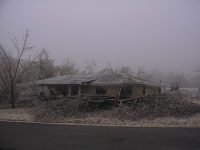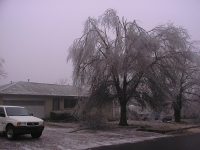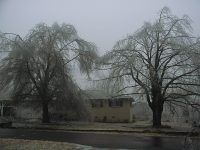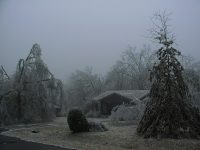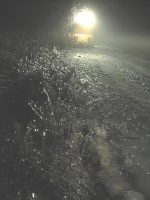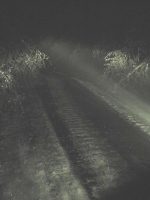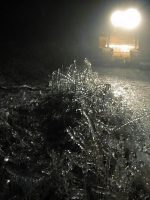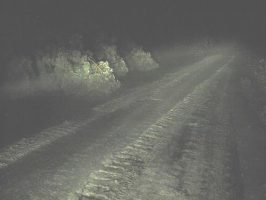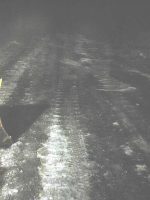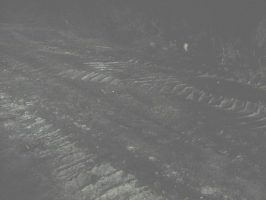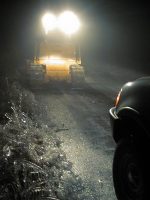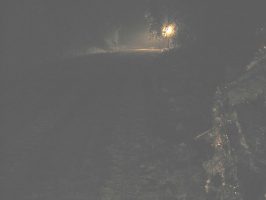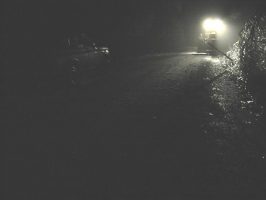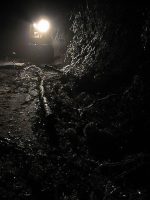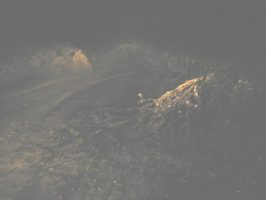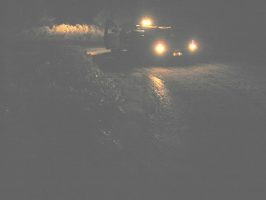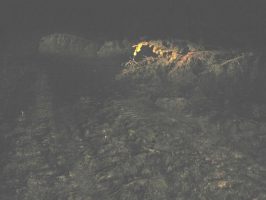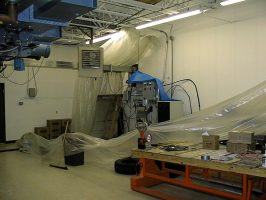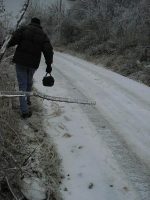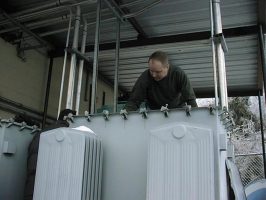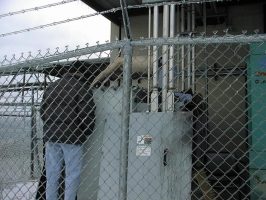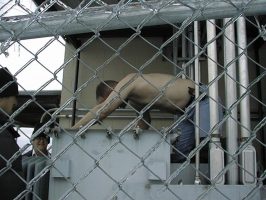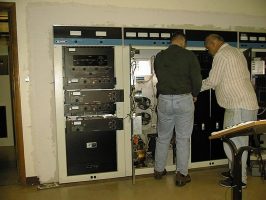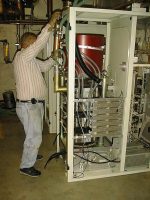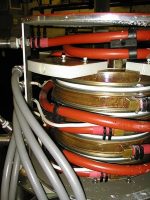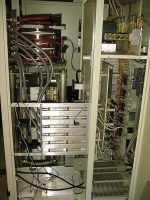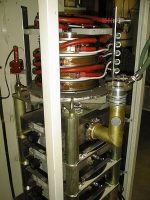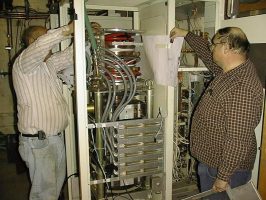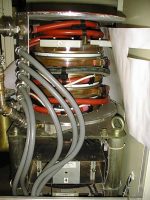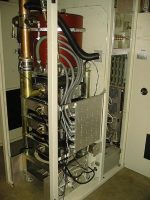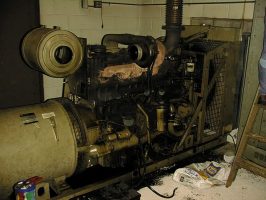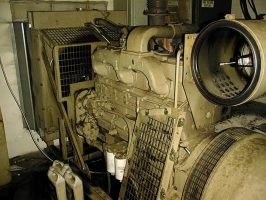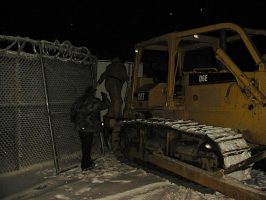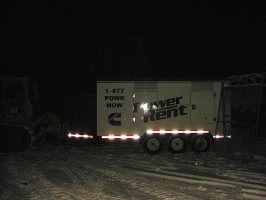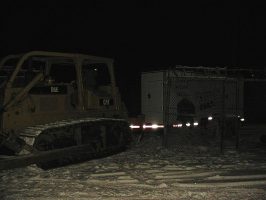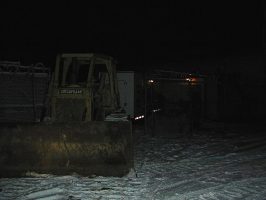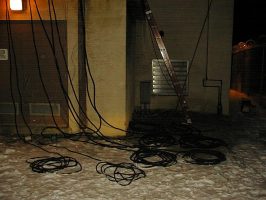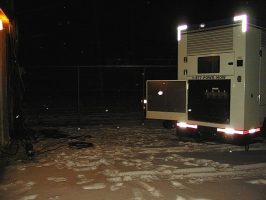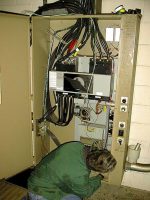What follows is a blow-by-blow retelling by Larry Friddle (my Asst. Chief Engineer at the time) on 10 JAN 2001 of a very difficult and stressful couple of weeks where everything seemed to be going wrong and the weather was definitely set against us…
My name is Larry Friddle. I am the Assistant Chief Engineer at ABC 40/29 and have been in television broadcasting for over twenty years. The events of the last two weeks have been the most catastrophic I have ever witnessed for a television station. Allow me to take you for a behind the scenes look at ABC 40/29 as disaster after disaster strikes and the effort made to restore your television service.
CHRISTMAS DAY, December 25, 2000 Monday
Everything of course begins on Christmas day, December 25, 2000. Freezing rain began falling over the 40/29 viewing area just as the weather men had predicted. By mid day, most of the streets were coated with a layer of ice and people were canceling or changing their Christmas plans. Almost unnoticed was that the ice was also building up on overhead power lines and tree limbs. It was also building up on other things. 40/29 Chief Engineer Sean Torbett had taken on call responsibility for KHBS for the holiday weekend. Sometime during the mid afternoon the control room operator on duty at KHBS called him to report that the transmitter atop Cavanal Mountain near Poteau, had an alarm condition. Ice was building up on the antenna to such a thickness that a large portion of the transmitted power was hitting the ice and being reflected back down into the transmitter instead of being transmitted over the air. If the amount of this reflected power is allowed to exceed a certain level, expensive damage to the transmitter will occur and we would be off the air for a long period of time while repairs are made. To prevent this, the transmitter has automatic monitoring that will shut it off at a certain threshold of reflected power. The alarm was an indication that the reflected power level was approaching that threshold. The only solution (besides getting rid of the ice) is to reduce the amount of power being transmitted to keep the reflected power below the critical level. Sean gave orders for the operator to keep a close watch on the situation and to reduce power as necessary to keep the reflected power at an acceptable level. Power was reduced to 80% and everything else continued normally, except we knew we were beginning to loose viewers in the fringe of our coverage area.
December 26, 2000 Tuesday
The rest of Christmas day was fairly routine. At midnight, the studio crew called and informed me that their relief workers were unable to make it to the studio, but they were willing to pull a double shift if necessary. I authorized the overtime and told them to call me if the Sunrise crew could not make it in. They called me at 4:00 AM to say the Director was not able to get out of her driveway, but other than that we had a full crew. I had picked up the company four wheel drive vehicle Sunday in anticipation of such a problem, so I got up and drove from Van Buren to Fort Smith. I picked up the Sunrise director at her house and delivered her to work. Along the way the night sky was lighting up with blue flashes as power lines began falling all over the city. At one point an Asian lady came out of her house and flagged me down. I stopped and rolled down my window. She said that her lights kept flickering off and on and was afraid that her house was on fire or something. I pointed out the ice on the trees and power lines and the flashes of blue and told her it was being caused by the ice. She was surprised. She said she had never seen anything like that. I told her that in all probability the electric would eventually go completely off and be off for a long time.
The Director and I arrived at the KHBS studio around 5:00 AM. The control room immediately informed me that the transmitter had lost electric power from Kiamichi electric at 4:15 AM and was now running on generator power. They were attempting to report the outage to Kiamichi as per normal procedure but the line was continuously busy. I told them to forget it. I figured that by this time they had so many lines down that there would be nothing they could do anyway. The transmitter power was holding at 80%, the generator was running normally, and we had topped off the fuel tank last week. Our tank holds enough diesel to run the transmitter for about 40 hours, so we had time. Most of the day of the 26th was spent ferrying critical people to and from work. Around noon, Bill Harper who owns KTCS called me. The main KTCS transmitter is also located on Cavanal Mountain. He asked me if we had been able to get in touch with Kiamichi electric. I said we hadn’t, he said he couldn’t either. He said he was on his emergency generator and thought he had enough fuel to last until about noon the next day. I told him that was about how long ours would last. He asked what was our plan if the electric didn’t come back on by then. I told him that I planned to start hauling diesel up in barrels the first thing in the morning if the electric wasn’t back on as I knew no tanker trucks would be able to get up the mountain. He said that wasn’t an option for him since his generator ran on propane. We wished each other good luck.
Throughout the day, freezing rain continued to fall. By mid afternoon, the ice build up on the transmitter antenna was to the point that we were having to reduce power to 30% to keep the reflected power level within limits. Our Satellite dishes that receive programming, weather data, news feeds, and so forth were getting such a layer of ice that they stopped working. We had to take garden hoses and use hot water to melt the ice to get them working again. We had to repeat that process several times throughout the day as the freezing rain continued to fall. About 4:00 PM we lost the data telemetry signal from the transmitter due to ice build up on it’s antenna. This is the signal that feeds the remote control computer with all the transmitter site information. Without remote control information, we would be unable to control the transmitter or monitor it’s condition. We have a backup for calling the transmitter site with a modem using regular telephone lines. A crowd gathered around the terminal as I gave the commands to dial. If the phone line was down, that was the end of the story. There was a collective sigh of relief when the transmitter modem answered and our remote control screen once again filled up with various meter readings. By now it was becoming clear that the entire city was dying a slow death. It was clear that electric was out over a very large area and that it would be off several days. I had a quick meeting with Sean and our General Manager, Jeff Bartlett. I outlined the electric condition, our generator fuel situation, and pointed out that if we remained on the air continuously we would run out of generator fuel about noon tomorrow. I told them that based on past experience we could expect the electric to be off several days. I also said that it was very likely that we would be unable to get to the transmitter site for at least a couple of days. I told them that if the transmitter site were allowed to loose power for any long period of time permanent damage to the transmitter cooling system could occur which would keep us off the air long after power was restored. I recommended that we deliberately shut down the transmitter during the night to conserve as much fuel as possible. Jeff wasn’t happy but agreed to shut down the transmitter from 11:00 PM until the Sunrise news cast at 5:30 AM. At least the news at KHOG was good. They were having no electric or antenna ice problems and the 29 transmitter was running normally, at full power.
About 6:30 PM, Sean went home and I stayed at the studio to keep an eye on things. I didn’t have to wait long. Around 7:30 PM the transmitter gave another alarm. It was starting to overheat. I have mentioned the cooling system before and now I’ll explain this a little better. The transmitter uses a pair of tubes called Klystrons. These things are monsters that stand about four feet tall and weigh about 500 pounds and cost over $60,000 each. They are only 70% efficient, which means for every 100 watts of electric the transmitter uses, 30 watts is wasted as heat. Since we normally broadcast 60 thousand watts, that’s a lot of heat! In fact, it is so much heat that the tubes must be water cooled, just like your car engine. Pure distilled water flows through the body of the tube and to a device called a heat exchanger. The heat exchanger is like a giant car radiator. It pumps water through the tubes and back through four radiator coils which are about three feet wide and ten feet long. A blower sucks cooling air in from outside the building, through the radiator coils and exhausts the excess heat out through a roof exhaust. Earlier my concern had been that without electric power, the building would cool off and the water would freeze, bursting the pipes, Klystron tubes, and radiator coils. Now we were having a totally different problem, the transmitter was over heating. The remote control was showing that the air being sucked in from outside had a temperature of 200 degrees! The water temperature was rising to 150 degrees from its normal of 120 degrees. I knew what was happening. I had seen it before but not quit this bad. The freezing rain was building up on the cooling air intakes until it completely clogged them. No outside air was being sucked in to cool the transmitter. Although a concern, the transmitter should be able to keep running until the water gets up to about 200 degrees, so we crossed our fingers and hoped for the best.
Our luck ran out at about 9:00 PM. Transmitter alarms started going off, red lights flashing. We were off the air. The transmitter had shut down. I thought there was a chance that it had just gotten too hot and would cool off enough to be restarted shortly. Looking at the remote control readings dashed that hope. It was showing that there was no cooling water left in the system. It was all gone, something that had never happened before. Had it all boiled out? Did the system spring a leak? We had no way of knowing. There was spare water stored at the site, but someone had to go up there to put it in. We had done all that could be done by remote control. I called Sean and gave him the bad news and he in turn informed Jeff. We were still on COX cable in Fort Smith and Van Buren because we had a direct feed to the cable system from our studio. But most of the city was without electric or cable. Channel 40 had very few, or no viewers. Sean at home in Greenwood, said he would meet me in Poteau. We were going up the mountain.
It took over an hour to drive to Poteau and meet Sean there. The freezing rain continued to fall and the roads were very slick and hazardous. There were very few lights on anywhere. Sean and I put the truck in low range four wheel drive and began working our way up Cavanal Mountain. There were ice-laden trees in the road everywhere. We worked our way around them. Less than a quarter of a mile up the mountain we ran into a series of pine trees that had fallen completely blocking the road. There was no way around without a chain saw which we did not have. The truck was sliding all over the road, and we hadn’t even started up any incline yet! It was clear that we weren’t going to drive up that night. We got out of the truck and tried walking. We couldn’t even stand up, let alone climb a mountain. We spent several hours trying to get up the mountain before we gave up. The drive back was eerie. I had never seen Fort Smith so dark. There were hardly any lights anywhere. There were runway lights as I drove by the airport, but everything else was pitch black. From the Rogers Avenue overpass on Interstate 540, I could see that most of the city was pitch black. There were no lights over the central mall area. There were small pockets of streetlights in some places. Then there would be another blue flash of fire somewhere, and another section of lights would go out. It looked like some kind of war was going on. I finally got home just before 4:00 AM, a 24-hour day.
December 27, 2000 Wednesday
Sean was in early, making phone calls. It was clear to us that there was little chance of getting the pickup up the mountain. He called the pilot that flew Friday Night Flights for us to see if he could fly us up the mountain. He said no way. He called on the resources of our parent company, Hearst-Argyle. They had a company owned helicopter at our station in Kansas City and they would fly down as soon as the weather allowed. At this point the freezing rain had stopped, but it was overcast with no visibility. We received word that we were no longer on the cable either. The only station not present. We finally managed to get through to the cable company. They had gone on generator power and our receiver was the only one not plugged in to the generator. They plugged us in and at least we were back on cable, for what that was worth.
Sean called the National Guard to see if they could help us out. They said they couldn’t act unless the Governor or a court ordered them to do so for public safety. Since we were the only station off the air, they couldn’t justify that. Sean began calling construction companies to find someone that would take us up with a bulldozer. Finally Scott Construction on South Zero agreed to try it. I obtained barrels from S&S SuperStop in Van Buren and filled them with diesel. Sean left to go home and get his chain saw. I was following the bulldozer driver to Poteau and stopped to top off the gas tank in Pocola. When I arrived in Poteau there was no sign of Sean or the bulldozer. I knew that the bulldozer had been ahead of me, so I was afraid that he had gone beyond the meeting place. If he had, there would be no place to turn the big truck around on the mountain. I went on up the hill to the point where the trees had blocked the road the night before. There I encountered four teens with a pickup. They had saws and were cutting the trees off the road. They asked what I was up to. I explained that I was from Channel 40 and we were bringing a bulldozer in to take us to the top of the mountain. The said that they had just seen it down by the elementary school going the wrong direction. They said that when we got ready they would go along and help cut back the fallen trees. I thanked them, grateful for all the help we could get. They also said that the ice became worse just a little further up the road and didn’t think the truck would make it. I went back down the road and found the bulldozer driver at the meeting place. He had taken a wrong turn. Sean arrived a few minutes later. We loaded survival gear, test equipment, and chain saw, in the truck, unloaded the bulldozer, and began climbing the mountain. By this time it was dark. We made it up to the fallen trees, now cut back with no problem. The boys in the pickup were nowhere to be seen. We were feeling optimistic that we would make it. The plan was to tow the truck behind the bulldozer if the truck began to slip. We started slowly up the mountain, dodging fallen trees, but none completely blocking the road.
We made it around the first two switch back turns with no problems. The bulldozer track was breaking through the ice and making contact with the pavement, but the ice was getting thicker. We approached the third switch-back curve, and the bulldozer began a 90 degree turn. Without warning it began to slide sideways towards the inside of the curve, and a steep drop at the edge. There was nothing the driver could do but ride it out. It came to a stop inches from the drop off. The driver inched it back onto the road, and managed to get back to the up hill side of the road. This was very scary. The driver asked us if we wanted him to keep going. We told him yes, but if at any time he thought it was too dangerous, to give it up. He said he would continue but I decided that I didn’t want to have the truck chained to him! The next straight section of the road went well. The plan was to keep one track of the bulldozer off the uphill side of the road. The trouble with that plan was that fallen trees often forced him to go around them. We reached the forth switch back curve which forces the bulldozer to cross the road to stay on the up hill side. Once again it began to slide sideways finally coming to a stop at the edge of the road. The driver inched his way back on the road and was pointing in the right direction so he started climbing the hill again. By now the bulldozer tracks were no longer breaking through the thick ice. Our convoy was joined by another vehicle that was following our truck. The scene looked like some type of sci ence fiction movie. It was pitch black. The lights shining through the fog from the bulldozer on the ice in the broken down trees made it look like a trek across mars. Everyone dressed in thick arctic looking coats with overhauls and caps looked like space suites. The bulldozer continued a few yards up the road and then began sliding towards the down hill side, containing about a 20 foot sheer drop. I thought that was the end and the driver would be seriously hurt or killed if it went over the edge. Again it stopped inches from the edge. The truck also began to spin, despite four studded tires and all the weight on them. It was clear the truck wouldn’t go any further without help. Sean decided that any further attempts were too dangerous since we weren’t a third of the way up yet and already having this much trouble. The bulldozer driver got back across the road to the up hill side after sliding sideways a couple of more times. We began to turn the convoy around. The white truck behind us turned out to be ALLTEL technicians. He said he had a big generator that was on its way being pulled by a large truck. He decided that if a bulldozer couldn’t get up the mountain, that their truck pulling the generator wouldn’t make it either. He got turned around and we got our truck turned around. By this time the bulldozer operator was about to give out. He was holding his brakes on the mountain above all the trucks and said he couldn’t hold it much longer. Finally the trucks were out of the way and he carefully backed down to the switch back curve where he could turn around. About this time the boys in the pick up I had met earlier were coming up the hill. Since there is barely enough room to pass someone under good conditions, they went off the side of the road to let us by. I stopped to talk to them while the convoy eased it’s way down the mountain and then walked, slid down on foot. The last I saw of them they had managed to get their pickup sideways across the road and were saying that they weren’t going to give up until they made it to the top! We packed everything back up, loaded the bulldozer back on it’s truck and gave up for the night.
December 28, 2000 Thursday
The next day brought a whole new situation. The sun was trying to come out and it was warming up somewhat. The guys from ALLTEL called and told us that they had a bigger bulldozer and were getting to pull their generator up the mountain. By the time we arrived they had made it to the top and we had little difficulty in getting up ourselves following in the ruts the bulldozer had made. He continued to grade ice off the road the rest of the day, but it still required four wheel drive to make it.
We pulled up to the transmitter building and found that the generator was still running. This was surprising as we knew it should have been out of fuel long ago. It took us about 10 minutes to break through the ice on the gates before we could gain access to the building. It was hard to get the door open because the ice had also covered the air intake for the generator and it was sucking in air from the building creating a vacuum. I immediately set up a pump and began to pump diesel from the barrels in the truck to our generator fuel tank. The gauge on the tank showed completely empty. While I was doing that, Sean got a ladder and was going to get on the roof of the building to break the ice from the generator air intake. I looked up at the tower. The antenna looked like a big Popsicle, covered with ice. After a few minutes he came back and told me that it was so slick that he couldn’t get on the roof. He went inside the building and began to investigate what was wrong with the transmitter. He found that three couplings that hold sections of cooling pipe together were leaking and that had caused all the water to leak out. He began to repair the leaks with spare gaskets that we had up there while I continued to pump diesel to the generator tank. About this time I looked up in time to see a large chunk of ice fall off the antenna. I knew it was huge bunch of ice because the antenna is 50 feet tall and ice covering about two thirds of it had come loose. I watched it fall down onto the roof of the building with a loud crash. Sean came running outside asking what was that. I told him that the ice had just came of the antenna and hit the roof. He went back inside and came back outside yelling for me to come quick. I went as fast as I could across the ice. When I got inside the building I saw that the ice had caved in about a four foot section of the roof and icy water was pouring in and raining down on the electronic equipment below. Luckily we found a large quantity of plastic sheeting which Sean grabbed and together we managed to cover up the equipment and keep the water off of it. It was a miracle that Sean had not been able to get on the roof or the falling ice would have killed him.
I finished emptying the 165 gallons of diesel from the truck and went back down the mountain for another load while Sean continued to work on the water leaks so the transmitter could be restarted. That took me about an hour. When I returned, Sean had managed to repair one of the leaks and was working on another. I started pumping the fuel from the truck to the tank. I left the pump to run and grabbed a plastic hard hat and began to chip the ice off the transmitter air intake all the while knowing that if the ice had gone through a steel roof, my plastic hard hat wouldn’t be much protection. I got the intake clear of ice and managed to empty another 165 gallons and went back down the mountain for another load. I wanted to make sure the tank was as full as possible before we left that day. By the time I got back, Sean had fixed all the water leaks and had refilled the water tank. He restarted the transmitter and we were back on the air for the first time in three days. At least the ice that came off the antenna allowed us to bring the power level back up to 70%.
I went back down the mountain and brought up another load of diesel to top off the generator. We now had enough to last about 36 hours. By now it was after dark again and I was glad to go home and get some rest.
December 29, 2000 Friday
Friday was a good day. I took a crew back up to the transmitter. I put them to work hauling diesel up to refill the generator tank after running all night, while I completely checked out the transmitter. Everything looked normal except that we still had to keep the power at 70% to keep the reflected power within limits. I checked the air intake and found that ice had reformed over most of it, although we still had enough airflow. I chipped away the ice again. By the time we had the generator tank full it was after dark. It was encouraging to see Kiamichi electric trucks on the mountain and their lineman working up there. I got back to the studio and about 9:30 PM the remote control showed that Kiamichi had at last restored electric service. It takes about five minutes to switch from generator power so I decided to wait until after the 10:00 PM news to change back. I also wanted to make sure that the electric stayed on without blinking on and off. I changed to utility power about 10:45 and turned the generator off for the first time in five days. During the night we continued to have short power outages lasting for just a few seconds, not long enough to change back to generator but causing us to blink off the air for a few seconds. I posted my on call card and informed the control room crew to call me if anything went wrong.
December 30, 2000 Saturday
The phone woke me at a nice early 5:00 AM. Channel 40 had signed off earlier that morning and now it was time to sign back on, but the transmitter wasn’t coming on. I got up and dialed into the remote control system from my home computer and found that a relay was sticking. I cycled it a few times and was able to get the transmitter going after about ten minutes. I noticed that we were still on Kiamichi power which was good, everything else looked good. I didn’t know it at this time but in Fayetteville, the engineer on call at Channel 29 was also going through a problem with the Channel 29 transmitter refusing to come on. I went back to bed and slept for a couple of more hours. Around 11:00 Sean called and told me that Channel 29 had not been able to come on and the Fayetteville engineers had been working on it all morning. They had indications that the big transmitter tube (the Klystron) I described earlier had gone bad. He wanted me to meet him at KHBS and then we were going up to KHOG to help out. We arrived on top of the ice covered mountain where the Channel 29 transmitter is located about 1:00 PM and began running tests. Normally we do not keep spare tubes on hand because they tend to go bad if they are not in use. Even when you order one, the factory usually has to build it before they can ship it. We were lucky in that we did have a spare that had arrived a few weeks ago. The problem is that it is about a 10 hour job to change out the tube so we didn’t want to do that unless it was absolutely necessary.
During this time the operator at the studio called and asked if we had any idea how much longer we would be. We told him that since we still didn’t have a clue as to what the problem was, we had no way to guess how long it would take. He told us that the entire news staff was tied up answering the phones. People were wanting to watch the football games and weren’t very nice about it either. Some were even making death threats, others were threatening to sue us. I guess some people thought we could just turn it on any time we wanted to and were refusing to do so.
Sean had contacted the factory that built the transmitter and they told him there was a good chance that the problem was something fixable rather than the tube. Our tests showed that it was possible that the high voltage power supply that supplies 24 thousand volts to the tube might be the real cause. This power supply looks like one of those big electric company transformers you see at substations. All the components are located in insulating oil to keep them cool. The problem now is that this thing is located outside, where it is very cold. We had a spare but it would have to be installed in the cold oil, outside in the freezing cold. We unbolted the lid and Sean took off his coat and shirt and went down into the oil to replace the parts. I looked at a temperature gauge on the oil. It showed zero degrees Centigrade, or freezing. I turned up all the heat in the transmitter building as high as it would go. It took about half an hour for Sean to replace the part. When he got back inside, he dried off and warmed up while we fired up the transmitter and tried it out. It was still bad. Now we had a new set of problems and it soon became clear that the parts Sean had just installed were themselves bad. We had no choice but to put the original parts back inside. We looked at Sean and told him only the chief engineer was paid enough and dedicated enough to go into the oil in that kind of weather, so for the second time Sean took off his shirt and went down into the oil to replace the parts.
We were back on the phone with the factory and were given a new sequence of tests to try. This time we got some results that pointed to a part of the tube that we could work on. But first we had to dismantle a good part of the transmitter and the top section of the tube to get to it. Sometime around 6:00 PM we finally got down to the heart of the tube. We found that a water hose that carried cooling water to different areas inside the tube was leaking and that was causing one of the wires carrying 24 thousand volts to short out. We replaced the leaking hose and replaced the shorted high voltage wire.
Sometime around 9:00 the control room operator at KHBS called. The Kiamichi electric at the Channel 40 transmitter had blinked off and the transmitter would not come back on. All attempts to get it back on had failed. We attempted to call in other maintenance engineers but no one answered the page. It was a two hour drive from the Channel 29 transmitter. Luckily I had a remote control program disk in my brief case. I took the Channel 29 remote control computer and reprogrammed it to dial into the Channel 40 remote control. I was then able to take control of the Channel 40 transmitter. I discovered that the turn on problem was the same relay that had caused the problem earlier in the morning. I applied the same trick and got the relay unstuck. The only problem was that the sound transmitter had blown a fuse when the electric kicked on and off. Normally the picture is transmitted by one half of the transmitter and the sound by the other half. I did a patch called multiplexing in which the picture half of the transmitter is used for both, but at reduced power. But at least we were back on the air. Soon there after I was able to contact Lou Merlo, the Maintenance Supervisor for KHBS, who was on vacation. I had him to go to the transmitter on Cavanal Mountain. He replaced the blown fuse in the sound portion of the transmitter and restored normal operation just after the 10:00 PM News was over. He was also able to change out the defective relay that was causing all the problems with turn on.
Meanwhile, back at 29 we ran a turn on test and everything showed good to go. The only problem was that the transmitter and tube were still torn apart into little pieces. It was now after 11:00 PM and it took us another two hours to get everything put back together into a working system. One last check to make sure everyone was clear of the high voltage, and Sean hit the on button. We were back on the air finally. We packed up and went home. I finally got to bed around 4:00 AM.
December 31, 2000 Sunday
I woke up again to the phone ringing at 7:30 AM. I thought “OH NO — Not Again” but it was just the pastor of my church. He was asking me if I was planning on coming to church that morning. I told him that I was staying home because I had just gotten in bed but my wife was planning to be there. He said that I didn’t understand, to go look outside. I opened the drapes and looked out at about two inches of fresh snow. He said he was canceling services. I told him that was fine with me because I was planning on sleeping anyway and my wife wouldn’t drive in the snow. I went back to sleep and got up around noon. I called the control room at KHBS and asked if everything was OK. They said that they were fine but that KHOG was off the air again. Sean was on his way up there and the Fayetteville engineers were already working on the problem. I called Sean and asked him if he wanted me to come up to help. He told me to hang around in case something happened at KHBS. They opened the Klystron and found the water hoses were leaking again. They had plastic spring type hose clamps. Sean went to an auto parts store and bought some small hose clamps. A few hours later the transmitter was back on the air, but was unable to make more than 30 % power for some reason. Suddenly the tube had an internal arc and then the power came up to about 80%. It was clear that the tube was damaged. That means that sometime soon we will have to replace the $60,000 tube.
January 1, 2001 Monday
Great day! It was supposed to be a holiday and it was the first day in more than a week where I got a full nights sleep and wasn’t awakened by a ringing phone. I checked in with the control rooms. Everything was going normally. KHBS was still running 70% power because of the reflected power problem and KHOG was down to 75 % power due to the bad tube. Other than that, everything was OK.
January 2, 2001 Tuesday
Another good day with the same conditions as yesterday. The stubborn ice was still hanging on to the KHBS antenna forcing us to remain at 70% power.
January 3, 2001 Wednesday
Today started out fairly well and we were surprised when the transmitter Off The Air alarms began to sound at about 9:30 AM. Kiamichi electric had gone off again. Our emergency generator started as normal and within a few minutes we were back on the air using generator power. We were really surprised when about 10:20 AM the alarms started sounding again. For the last few minutes the generator voltage had been erratic and now the generator had shut down completely. We tried to restart it without success. We were off the air with no source of electric power to run the transmitter. Hidden in amongst the page full of alarms was a very ominous listing; “Fire Alarm in Generator Room”. Maintenance Supervisor Lou Merlo and Broadcast Engineer Jack Jones began the long drive from the Fort Smith studio to the transmitter building on Cavanal Mountain. It is an hour drive at best and when we are off the air, it is agonizing long. We also called Cummins Mid South, the company that maintains our generator, and arranged for their service man to meet us up there.
Back at the studio, the phones were beginning to ring off the hook. Tonight was the Orange Bowl, with Oklahoma playing, and everyone wanted to know if we were going to be back on in time for the game. Of course there were the few that were making their threats to blow up the building or kill someone if we didn’t get back on the air right now. We lost track of how many times we were going to be sued.
Lou and Jack finally arrived at the transmitter. What they found was horrible. The generator had caught fire. The automatic fire extinguisher system had put out the fire but Lou still discovered fire burning in the air filters. He threw the filters outside on the ice. Our electric was still off and it looked like the generator was a total loss. We had been trying to contact Kiamichi electric ever since the electric had gone off, but the number was constantly busy. A lot of people had been calling us wanting to know our special number for getting through to Kiamichi electric. I assure you, we don’t have one. All we have is the same 800 number you have, and it is just as difficult to get through to them for us as it is for you. We assigned one person to do nothing but keep dialing their number over and over. We were never able to get through to them the entire day.
The generator service man arrived and confirmed our worse fears. There was absolutely no way that generator was going to be running again any time soon. With his help we began trying to find a generator to rent. This isn’t as easy as it sounds. It’s not like getting a generator you use at home to keep your lights and heat on. Our transmitter needs thousands of watts to run. We finally found a generator large enough to run everything, in Little Rock. It would take four hours minimum to have it brought up to Poteau. Then there was the problem of getting it up the mountain, with was still covered with ice in many places. The generator was as large as a mobile home, and no truck was going to be able to pull the hill with it. Chief Engineer Sean Torbett began to make calls to find a bulldozer large enough with the right type of hitch to pull the generator up the mountain. He also contacted Glidewell Electric, our electrical contractor. We would need electricians to hook up the rental generator to the building. They dropped everything for us and headed for Poteau.
By now it was 4:30 PM, and we finally got a break. We had not been able to contact Kiamichi electric, but the electric came back on. We immediately restarted the transmitter and were back on the air. We breathed a sigh of relief, but we still weren’t out of the woods yet. Would the electric stay on long enough for us the air the Orange Bowl? No one had any way to know. About 6:00 PM the rental generator arrived at the foot of the mountain from Little Rock. It was connected to the back of the bulldozer and the long slow crawl up the mountain began. It took a while, but it finally made it to the top of the mountain sometime after 8:00 PM and the electricians began wiring it up to our transfer switch. The transfer switch allows the building to get electric from Kiamichi or from the generator. The game was on and was turning out to be a very close game. Once during the most exciting part of the game, the electric went off again. The people wiring the generator were almost done, but it wasn’t ready yet. The electric was off for about 10 minutes and people were not only calling with the death threats, I imagine some of them were getting out their guns! I breathed a sigh of relief when the electric came back on and the transmitter fired back up. Shortly after that, the workmen reported that the generator was wired up and tested. Twelve hours after the fire, the new stand by was ready to go. The electric stayed on however and everyone went home glad that this day was over with. We did have one good thing happen, the remaining ice finally fell off the antenna and when we were on the air we were able to go back to 100% power. The bad side was that the ice fell on the roof of the transmitter building knocking another hole through the roof. We had to put up more plastic sheeting to keep leaking water from shorting out the transmitter.
January 4, 2001 Thursday
It was getting to the point that I really hated to come to work. The electric from Kiamichi electric went off again at 10:12 AM. The new generator immediately kicked in and we were only off for a few minutes during the time it took for it to start up. We got a real sick feeling when the Off The Air alarms began sounding again at 11:18 AM. The new generator had shut down and the electric was still off. We called Cummins Mid South. Their main service man was in Springdale and it would be a while before he could get there, but he had an assistant in Sallisaw that could be there within an hour. Lou Merlo headed for the mountain to see if there was anything they could do. The arrived about an hour later and met with the generator service man. The generator was brand new, but the part that regulated its running speed was not working which caused it to malfunction and shut itself off. The service man worked on it but was not making much progress. At one point KHBS Chief Engineer Sean Torbett was overheard talking to the main office at Cummins Mid South telling them to get a helicopter or whatever it took to get the parts and someone up there to fix the generator or get it off our property so we could get one from someone else. The service man was finally able to get the generator to run by scavenging some parts from our old generator, and we got back on the air at 5:45 PM. We were able to get through to Kiamichi electric at about 4:00 PM. They told us they would have the electric back on as soon as possible.
January 5, 2001 Friday
I came to work at 2:00 PM but I could tell walking across the parking lot that things weren’t going well. One of the ladies that answers our phones was outside smoking and looking very stressed out. I said “Let me guess, we must be off again”. She said yes, since about 12:30 and all of the little old ladies were convinced that we were deliberately turning it off everyday to keep them from watching “their stories”.
This time the generator had shut down at 12:29 and Sean and Broadcast Engineer Viju Parakkadan had gone up with the generator service man to see what was wrong. The electric still hadn’t come on since it went out Thursday morning. The guy we put busy continuously calling Kiamichi electric finally got through to them. They told him they were sending a lineman up the mountain immediately. Sean and the generator service man finally got the generator running again at 4:30 PM and we were once again back on the air. The electric was still off and we finally got through to Kiamichi electric again late in the afternoon. They assured us that a lineman was on his way up the mountain at that very moment. Every time we talked with Kiamichi they were extremely polite which is a testament to them. I am sure that the angry calls we were receiving were just a drop in the bucket compared to what they must have been getting. The rest of the evening went OK with no further generator problems, but no electric either. Viju hauled barrels of diesel up the mountain until the generator tanks were full.
January 6, 2001 Saturday
Sometime before 10:00 AM the electric finally came on. Lou Merlo turned off the generator, switched the transmitter back to utility power and topped off the fuel tank on the generator in case it is needed again. As of this writing, the electric has been on except for a few short blinks that knocked us off for a few seconds each time.
All I can say is I hope I never see another two weeks as bad as these were. I hope this diary and photographs give you some idea of our dedication to getting your television program back on as quickly as possible and to realize that some times, things are just beyond human control.

